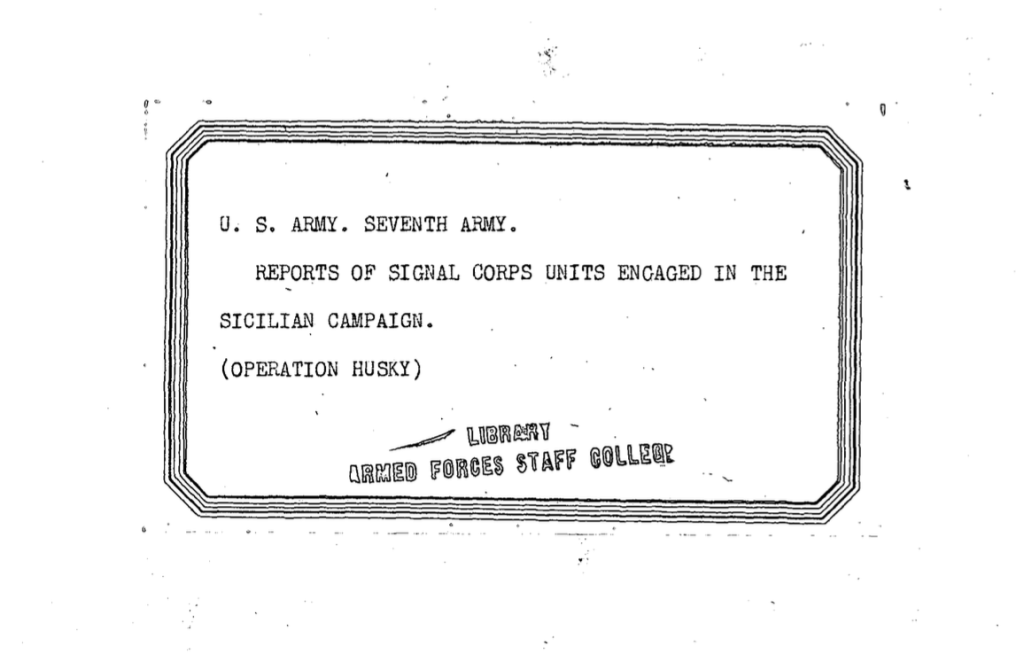Below is a collection of Signal Corps-related paperwork for use in WW2 Reenacting.
Radio
Templetone Model BP2-A5 Log Card – The Templetone Model BP-2A5 seemed to be some kind of morale radio for the troops. The log card would be placed under the front-cover so it would show when the cover was opened. Not sure why a morale radio would need a station log card?
Print in medium-weight beige cardstock. Print on both sides of the media and cut at crop marks to produce one Station Log card.
For a good history of the radio see: Templetone Model BP2-A5 “Morale Radio”.
BC-611 Frequency Card – This is the card that would go into the small window of the BC-611/SCR-546 radio
Form 159 – Number Sheet | Print pages on natural or ivory paper and stack+trim to the same size. Run a few beads of rubber cement along the top edge to have a tear-away stack.
I’m unsure what this was exactly used for.
Telephone
Signal Corps Station Log – Signal Corps paperwork to record traffic at what appears to be a telephone station. Form number unknown.
Print pages on natural or ivory paper and stack+trim to the same size. Run a few beads of rubber cement along the top edge to have a tear-away stack.
Other
Form 158 – Route Delivery List – Signal Corps form for delivering messages. Print 25 pages on natural or ivory paper and stack+trim to the same size. Run a few beads of rubber cement along the top edge. You’ll have a tear-away pad of 50 sheets.
A “route delivery” seems to connect more points.
M-209 Sheets: For use with the M-209 cipher.
Form 160 Local Delivery List – Signal Corps form for delivering messages. Print 25 pages on natural or ivory paper and stack+trim to the same size. Run a few beads of rubber cement along the top edge. You’ll have a tear-away pad of 50 sheets.
A “local delivery” seems to connect fewer points.
Message Book M210a Front and Inside – A printable pdf file for the M201a message book. This book would be used in a message center. It would be unlikely to appear in a map case. You can download the front+back here and the insides here.
Print on regular paper and then trimmed to size. The book has overall dimensions of approximately 6-1/8″W x 4-1/4″H x 1/2″ thick. Inside the book are 25 each triplicate message forms for regular use, three each duplicate forms for carrier pigeon use, and 25 sheets of tracing paper. The back cover has an extension that can be placed under the topmost form, so that it can be filled out without marking the carbon-copies of the following forms. The book also includes instructions for its use and a list of authorized abbreviations.
For best results, print on 8-1/2″ x 11″ US letter-sized paper with no scaling. Finished forms should be 4.75in wide by 4.25in tall.
When cutting it out, save 1/4 inch of space on the left-hand side. That way the staples don’t go through the message part.
I’m not sure if anyone is reproducing these, but if they are, I’ll add a link. Note that this only includes a single blank message form and not the carbon copies or map overlay.
Now there’s also an M 210-B message book, which looks like it came out in late 1944. This is according to the Signal Corps Technical Information Letter Nov 1944 No 36. The major differences are some measurement tools on the front cover, the removal of the pigeon forms, and map overlays. This was all done to help speed up the message processing, as it was found that soldiers experienced difficulty removing the copies in the M210a book.
There’s also an M-105-A message book. I’m not sure what the difference is. If I find out I’ll write about it.
Signal Corps Technical Information Letters
Signal Corps Technical Information Letter No 18 – May 1943. Outlines new training methods, procedures, and equipment. One interesting story is how local police captured an illegal pinball den and donated the machines to Ft. Monmouth to be used as needed.
Signal Corps Technical Information Letter No 36 – Nov 1944. Outlines new training methods, procedures, and equipment. Discusses the fungi and moistureproofing techniques (which is some kind of lacquer spray), as well as the Silica Gel, used to pack equipment, and an anti-radio jamming exercise, among other interesting and nuanced signal corps minutia.
27th Signal Company Switchboard Trailers – During the Phase 1 Nansei Shoto Operation on Okinawa, the 27th Signal Company of the 27th Infantry Division created a special trailer to house a BD-96 switchboard and it’s BD-97 panel, test sets, EE8 field phones and other incidentals required to operate a BD-97 switchboard in a combat operation. The BD-96 is used to run up to 40 lines into it.
The trailer was used to be as mobile as possible during the operation. Being mounted in a trailer makes it so.
This type of configuration may have been used at the Battalion or, more probably, at the regimental level.
BD-96 and BD-97 images come from: TM 11-487B Directory of Signal Corps Equipments: Wire Communication Equipment.
Basic Wire Communication: Lineman’s Handbook: Wire Training Section Central Signals Replacement Training Center, Camp Crowder Missouri – This is a printable booklet and gives a very quick review of wire splicing, terminology, and organization
TM-184a Terminal Board Fabrication – This is a pdf that shows the schematics of how to fabricate the TM-184a terminal board. It is used as a terminating or test point in tactical field wire systems.
TM-184 T1 and T2 replace this. You can view the instructional manual for them here.
TM-184a T1 and T2 hold 7 pairs of wires. TM-84 holds 5 pairs of wires.




























